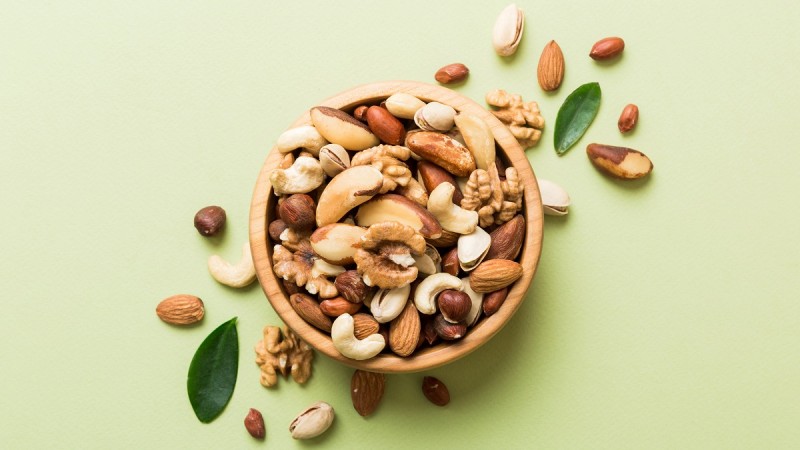Nuts: surge in EU spending
July 30, 2025 at 12:19 PM ,
Der AUDITOR

EU nut importers spend record amount
EU importers spent a record EUR 3.8 billion (USD 4.4 billion) on fresh or dried nuts in the first half of 2025 marking a stunning 33% rise on the same period last year. Spending has risen sharply by double digits for nearly all nuts, with the noted exception of peanuts and pecans that saw more moderate one-digit rises. Walnuts are displaying the sharpest rise of more than 60%. As much as eight of the surveyed eleven nuts have reached a record import value.
The USA are the most important trading partner by far with an overwhelming market share of 49% in terms of import value. Second-placed Vietnam follows with a much smaller share of 10% and Argentina is next in line with 9%. For almonds, pistachios, walnuts and pecans the USA are the top trading partner for the EU. The USA also ranks third for peanuts and hazelnuts.
Almonds top the chart
The EU imported almonds worth EUR 810 million (USD 935 million) in the first half of the year. The USA (95.3%), Australia (2.5%) and Afghanistan (0.4%) are the main suppliers.
Pistachio imports amounted to a record EUR 794 million (USD 917 million) with the USA as main trading partner (79.7%), followed by Turkey (7.6%) and Iran (6.7%).
EU importers spent the highest value on record over EUR 574 million (USD 663 million) on shelled and inshell peanuts. Main trading partner is Argentina (61.5%), followed by China (12.3%) and the USA (8.4%).
EU cashew nut imports hit a record EUR 560 million (USD 646 million) in January to June 2025. Vietnam accounts for the lion’s share of 69.4%, followed by Ivory Coast with 15% and India with 6.2%.
EU importers spent a record EUR 515 million (USD 594 million) on walnuts. Main trading partner are the USA (60.5%), followed by China (14%) and Ukraine (11.8%).
EU imports of hazelnuts also climbed to a record EUR 284 million (USD 328 million) with Turkey as leading supplier (42.2%), followed by Chile (25.8%) and the USA (11.8%).
Pine nut imports are up at EUR 94 million (USD 109 million). China is the main trading partner by far with a market share of 78.5%. Turkey and Russia are next in line with much smaller market shares of 7.7% and 7.1% respectively.
Pecan imports hit a record EUR 88 million (USD 102 million) and have grown continuously in the past three years. The USA (57.8%) and Mexico (37.0%) are the main suppliers with South Africa (3.6%) next in line.
Accounting for market share of 83% Bolivia is the main trading partner for Brazil nuts, followed by Peru with a much smaller market share of 14.1% and Brazil with only 2.0%. The import value also surged to a record EUR 53 million (USD 61 million).
Macadamia nut imports reached EUR 33 million (USD 38 million). South Africa (56.0%), Kenya (17.7%) and Australia (13.9%) are the main trading partners.
Kola nut imports also hit a record EUR 1.3 million (USD 1.5 million). Ivory Coast (32,2%), India (21.4%) and Jamaica (13%) are the three top suppliers.
|
EU nut imports (EUR) |
|||
|
Product |
2024 |
2025 |
Diff. |
|
Almonds |
557,857,217 |
810,910,427 |
45.4% |
|
Pistachios |
606,896,038 |
794,894,481 |
31.0% |
|
Peanuts |
542,713,322 |
573,746,494 |
5.7% |
|
Cashews |
411,941,359 |
560,708,032 |
36.1% |
|
Walnuts |
317,895,190 |
515,760,172 |
62.2% |
|
Hazelnuts |
222,284,864 |
284,433,304 |
28.0% |
|
Pine nuts |
70,229,921 |
93,759,012 |
33.5% |
|
Pecans |
81,653,915 |
88,182,636 |
8.0% |
|
Brazil nuts |
34,830,559 |
52,721,570 |
51.3% |
|
Macadamia nuts |
25,601,489 |
33,025,000 |
29.0% |
|
Kola nuts |
951,991 |
1,342,690 |
41.0% |
|
Others |
1,256,197 |
1,517,847 |
20.8% |
|
Total |
2,874,112,064 |
3,811,001,666 |
32.6% |
|
DG TAXUD Customs Surveillance, 01/01-29/06 |
|||
EU countermeasures off the table
EU importers will breathe a sigh of relief that the EU countermeasures for Trump’s tariffs are off the table after a deal was struck on Sunday. They comprised a 25% tariff for US peanuts as of 7 August and a 25% tariff for almonds as of December along with a 30% tariff for Brazil nuts, cashews, hazelnuts, macadamias, pecans and pine nuts as of 7 September and a 30% tariff for pistachios and walnuts. The deal that includes a 15% baseline import tariff for most EU products has prompted much debate and criticism within the EU in recent days as it is mainly regarded as a one-sided victory for Trump. Although zero-to-zero tariffs were agreed for certain agricultural products, exact details still need to emerge, and the deal needs to be finalised.
In addition, the US administration has reached deals with other countries such as Vietnam with a 20% tariff for Vietnamese products, Japan with a 15% tariff, the Philippines and Indonesia with a 19% tariff each. Negotiations with China are still continuing and rather mysterious exemptions exist for Argentina. Such deals may also shift market dynamics meaning that uncertainty persists that will affect market supplies and prices, despite the US-EU trade deal fending off a trade war.
View more
- price charts for nuts, dried fruit, oilseeds and many more products





